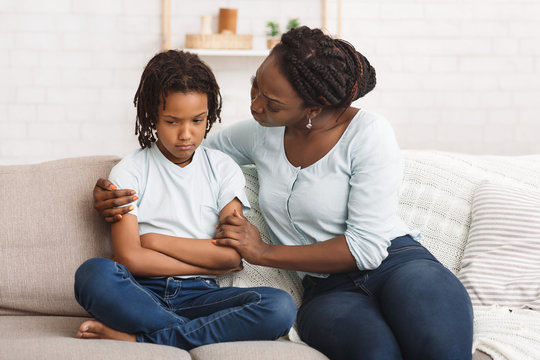Anger Management For Kids: See Experts’ 6 Healthy Ways To Deal With Explosive Feelings

PureWow turned to clinical psychologist Dr. Bethany Cook for the scoop on how to understand your child’s anger, as well as some kid-friendly coping strategies.
What Anger Looks Like in Children (and When to Worry)
Here’s the first thing you should know: Anger is a perfectly healthy and normal emotional response. And there are many reasons why your kid might experience it.
“Anger is a superficial, or secondary emotion, meaning it is a response to another emotion being triggered first,” explains Dr. Cook. So, what kind of primary feelings might make a person see red? This varies depending on the situation and the individual’s temperament, but sadness, fear, frustration, shame and anxiety are common culprits.
Unfortunately, these not-so pleasant primary emotions are a part of life, even more so for young kids who are constantly mastering new skills and being confronted with unknown situations. In other words, it’s entirely unsurprising that toddlers have a reputation for blowing a gasket on the regular.
“It’s a natural part of growing up and learning to regulate emotions,” explains Dr. Cook. In fact, a child younger than 4 may have as many as nine tantrums per week, with episodes of crying, kicking, stomping, hitting and pushing that last five to 10 minutes, says Denis Sukhodolsky, a clinical psychologist with Yale Medicine Child Study Center.
So if your toddler is experiencing intense feelings of anger on the regular, you can chalk it up to normal growing pains. That said, just because the height of the temper tantrum phase is in the rearview, that doesn’t mean your kid has banished the angry feelings or mastered the coping skills needed to deal with them.
Kids express anger in a variety of different ways, but parents should pay special attention to any display of emotion where aggression is present, says Dr. Cook. This includes active physical or verbal aggression towards self (like calling themselves stupid, cutting or otherwise harming themselves) or others (hitting or hurting peers and family or name calling).
It also can take the form of passive-aggression toward self (things like neglecting personal hygiene, refusing to eat or keep healthy sleep patterns) or others (like refusing to complete chores or schoolwork). No matter how your child’s unresolved anger manifests, the bottom line is that all these behaviors are a cry for help, explains Dr. Cook.
Fortunately, there are a few strategies that you can enlist to help teach your kid healthy ways to respond to these big feelings. However, Dr. Cook reminds parents that if all else fails and the behaviors continue to intensify, there’s no shame in reaching out to a professional directly for more support.
How Parents Can Teach Anger Management for Kids
1. Identify what’s causing the anger and give it a “voice” for your child
Kids, especially young ones, can struggle when it comes to expressing their feelings with language, says Dr. Cook. This in turn can cause fear, panic and (you guessed it) more anger. Although adults might not take too kindly to someone else labeling their experience for them, this is absolutely an acceptable approach with children.
“Labeling and explaining to your child what you believe they may be experiencing is important because it validates their experience and also teaches them not to be afraid of their feelings,” she says.
Let’s say, for example, you notice that your 5-year-old is putting together a new jigsaw puzzle when suddenly pieces start flying and tortured screams ensue. You might try an insightful question to the tune of: “Are you feeling frustrated because you couldn’t figure out which piece went here? I’ve felt frustrated like that many times before…Can I help?”
If you follow a similar script, Dr. Cook says your child will take comfort in knowing that it’s not just them—you’ve felt that way before and there’s a word for it, too.
2. “Create” the anger
If you’ve noticed your child has been struggling with anger, Dr. Cook suggests you engage them in an in-depth conversation about anger at a time when they are not already worked up.
Here are some questions to get you started: What does anger look like? Is it big or small? Does it smell? How does it move around? What color is it? What texture? Once you’ve tapped into your child’s imagination and homed in on the specifics of how they experience anger, you can work with your child to craft a representation of the emotion according to the description they shared.
(Think: a Lego tower, a drawing, or even a homemade stuffed animal if you’ve got sewing skills.) The end result? “[You’ve helped] make ‘angry’ tangible so that your child feels power over it and not vice-versa.”
3. Offer choices in the moment
So, what to do when your child is in the throes of a wild fury? Dr. Cook says to skip the rational explanations (“No, you can’t have a cookie right now sweetie, because you had your snack already…”) and instead offer your child two straightforward choices.
“When a child (or adult) is upset and feeling angry, they are no longer functioning from their frontal lobes—which house executive functions such as reason, logic and understanding—and therefore unable to make wise choices in the moment,” she explains.
Laying out choices for kids help then recenter when they feel out of control. For the example above, pull your kid out of their anger and back into a more rational state by asking them if they want their cookie after nap or after dinner.
4. Go over a wheel of emotions chart
There are many variations of this chart, but the aim is the same: to help children visualize emotions as multi-layered experiences, thereby increasing their emotional literacy.
Your kid will likely look at you like you have two heads if you simply start spouting off about primary and secondary emotions, but this wheel makes that reality easier to comprehend and, per Dr. Cook, it also offers a visual distraction, helping kids “shift cognitive lanes (from anger in the midbrain toward logic in the frontal lobes) simply by looking at something else.”
Once the intense emotions have faded you can engage in a more meaningful conversation that involves identifying the underlying feelings that trigger anger.
5. Use the five senses to recenter
The wheel of emotions is a useful visual distraction, but Dr. Cook says that all four of the other senses can serve the same purpose in terms of “getting out of our midbrain and back to logic and reason [thereby] offering immediate relief to both parents and kids.”
The way this works is by keeping some sensory items handy for whenever a volatile moment occurs. What type of sensory items? Good news, parents: It’s actually not bad to calm down your kid with a piece of candy, so long as it offers an over-the-top taste experience your kid doesn’t get too often (like a mint or a sweet-and-sour treat).
Fidget spinners and stress balls are an excellent way to use the sense of touch to recenter, while smelling salts and meditation apps can stimulate the senses of smell and hearing to the same effect. Finally, Dr. Cook recommends the healing visual experience that comes from being in nature, so whenever possible, calm your kid down with a nice walk outdoors—just don’t ruin the peaceful moment with a lecture, she cautions.
SEE ALSO: Educator, Glory Ubah Explains Why You Should Let Your Child Express Positive, Negative Emotions
6. Try a breathing exercise
“Deep breathing has been proven over and over again to help calm the nervous system and temper ones’ fight/flight/freeze response. That being said, you can’t tell someone to take deep breaths when they are angry,” says Dr. Cook.
For that reason, she recommends practicing deep breathing exercises with your child when they are calm, so that you can suggest it in either the lead-up to full-blown anger or the wind-down phase without a total fail. Umbrella breathing and square breathing are two popular mindfulness techniques that can help.
So, there you have it—six actionable tips for how to help your kid cope with anger. But one last thing before you try to tame the beast: “Each child is unique in how they process and respond to intense feelings of anger,” says Dr. Cook. So, don’t be discouraged if getting your kid to understand and cope with her feelings involves some trial and error.


